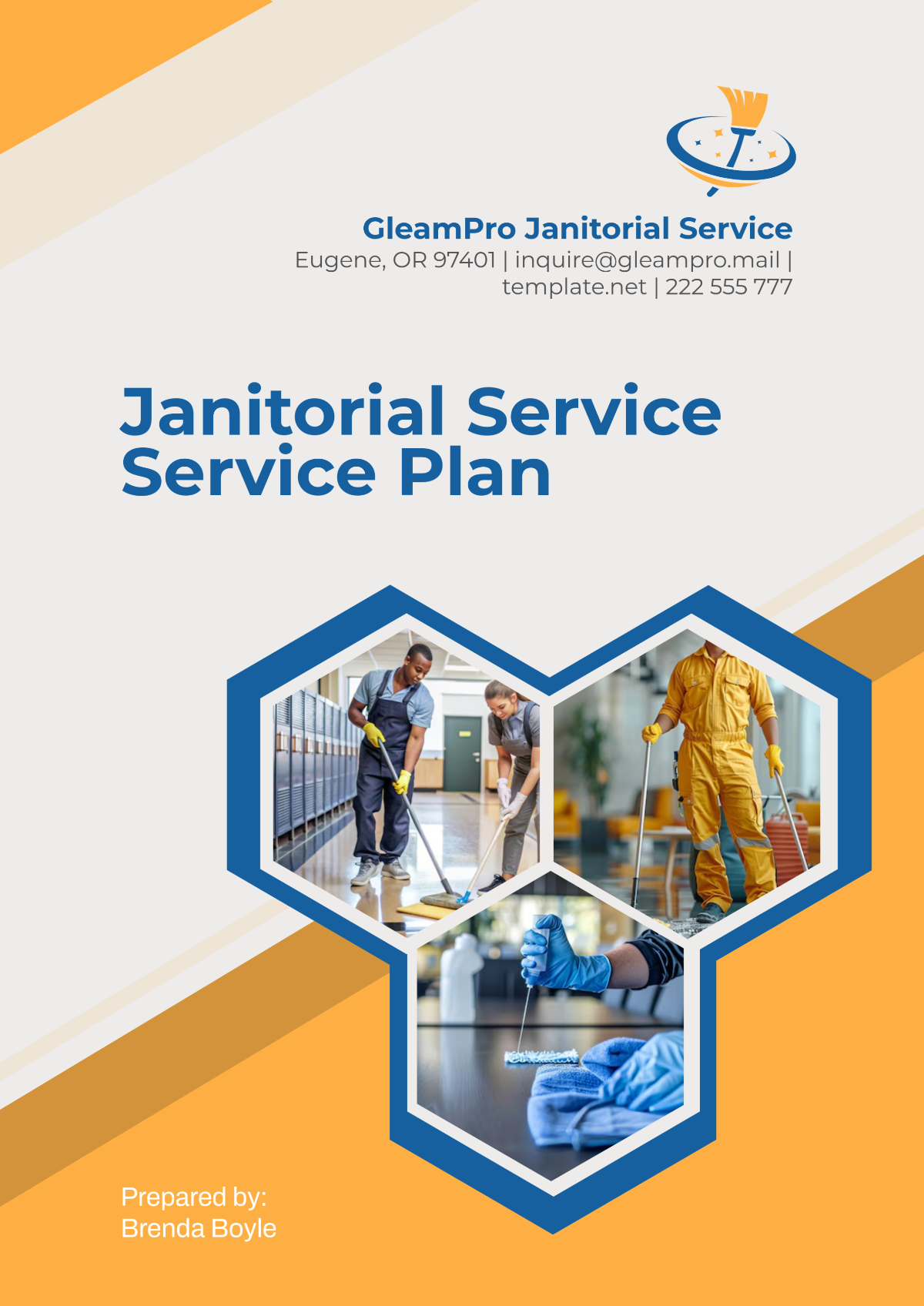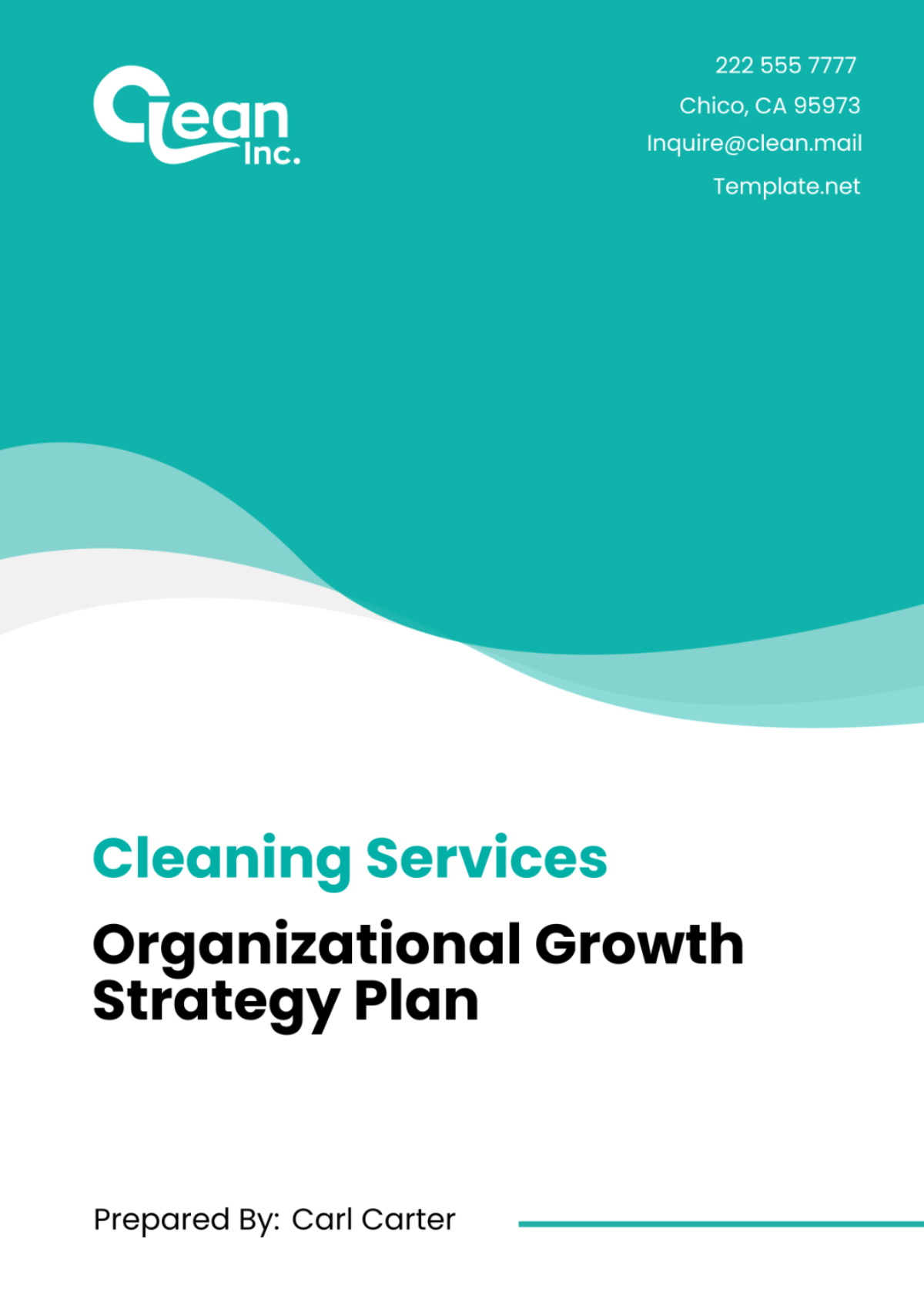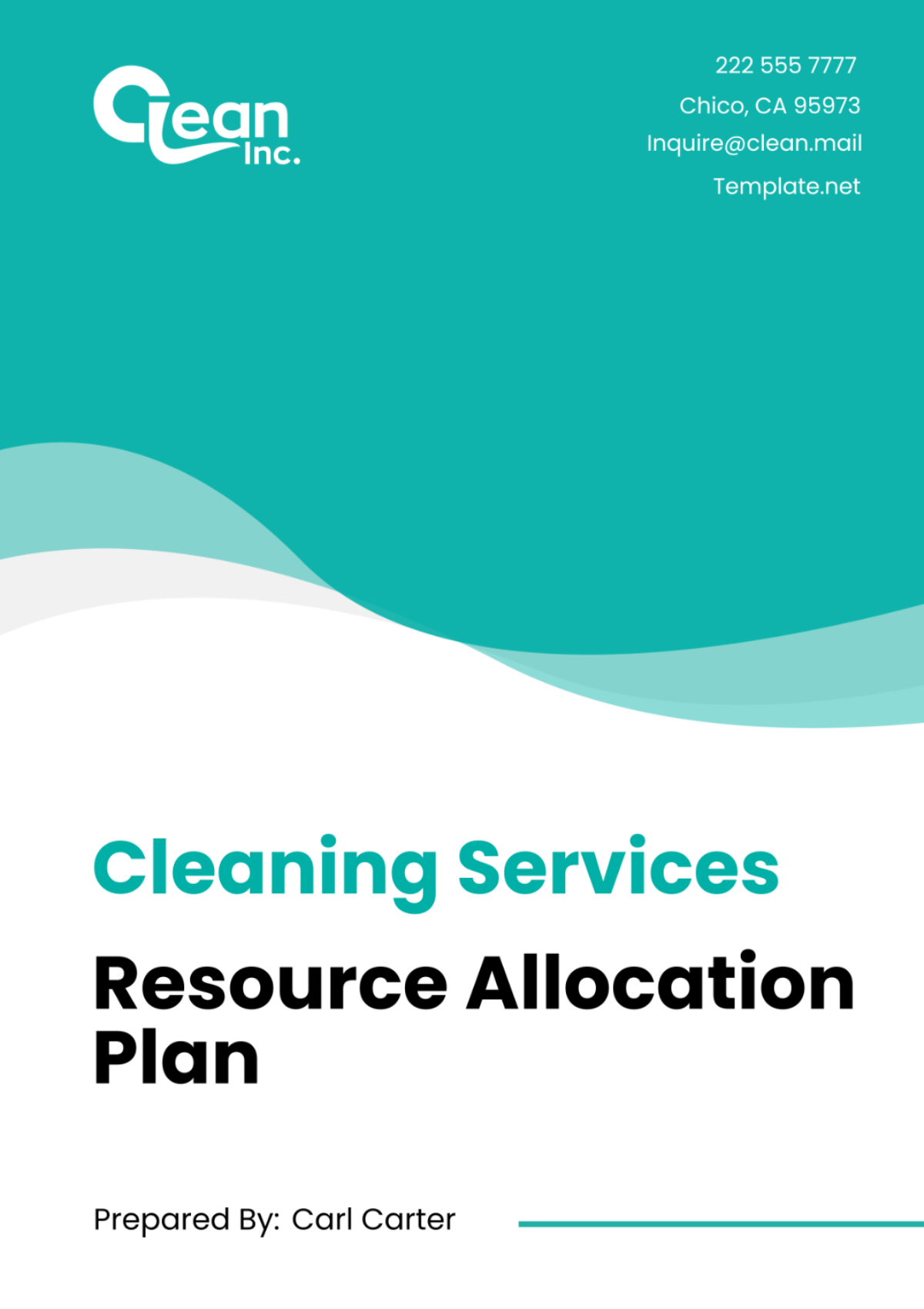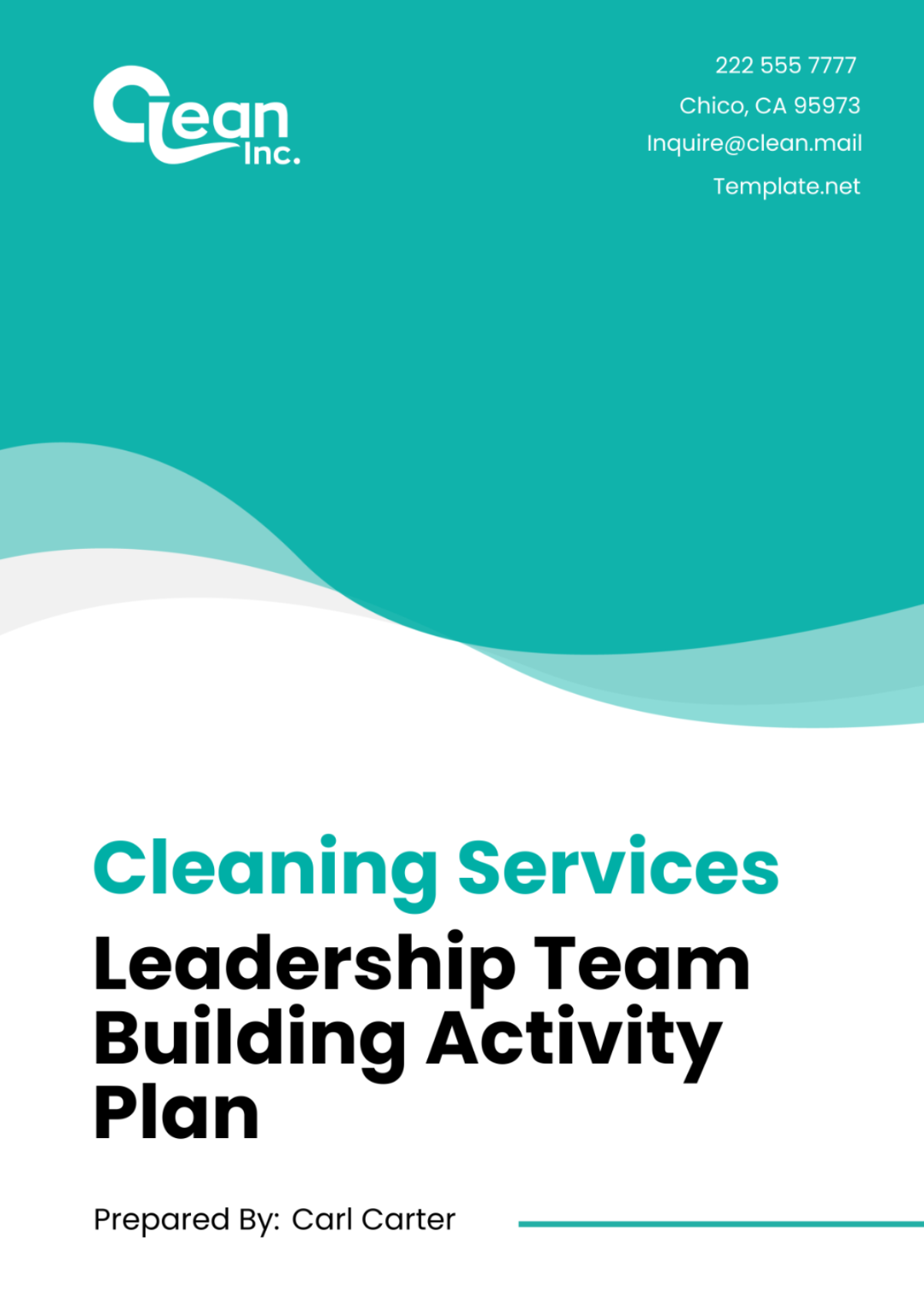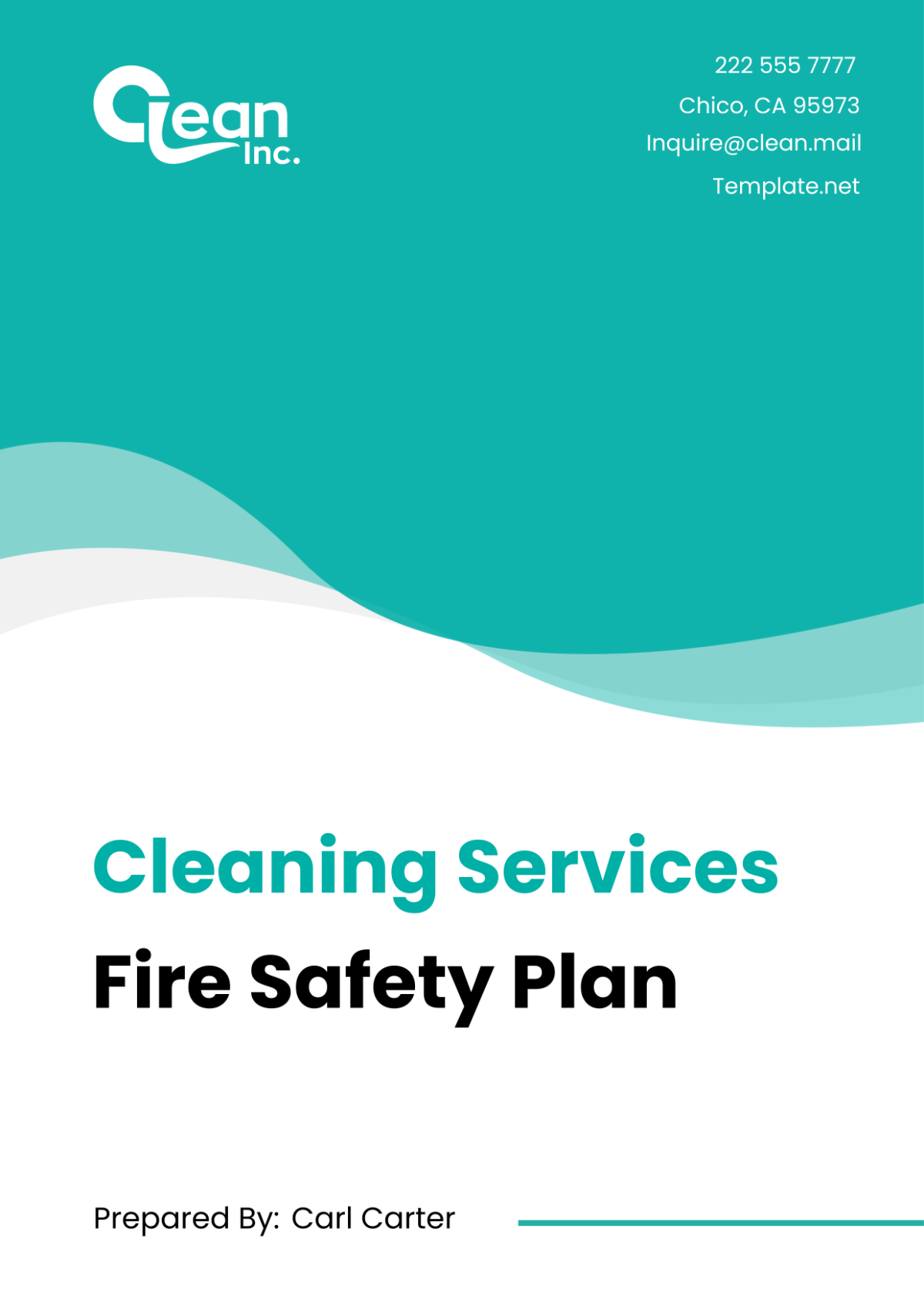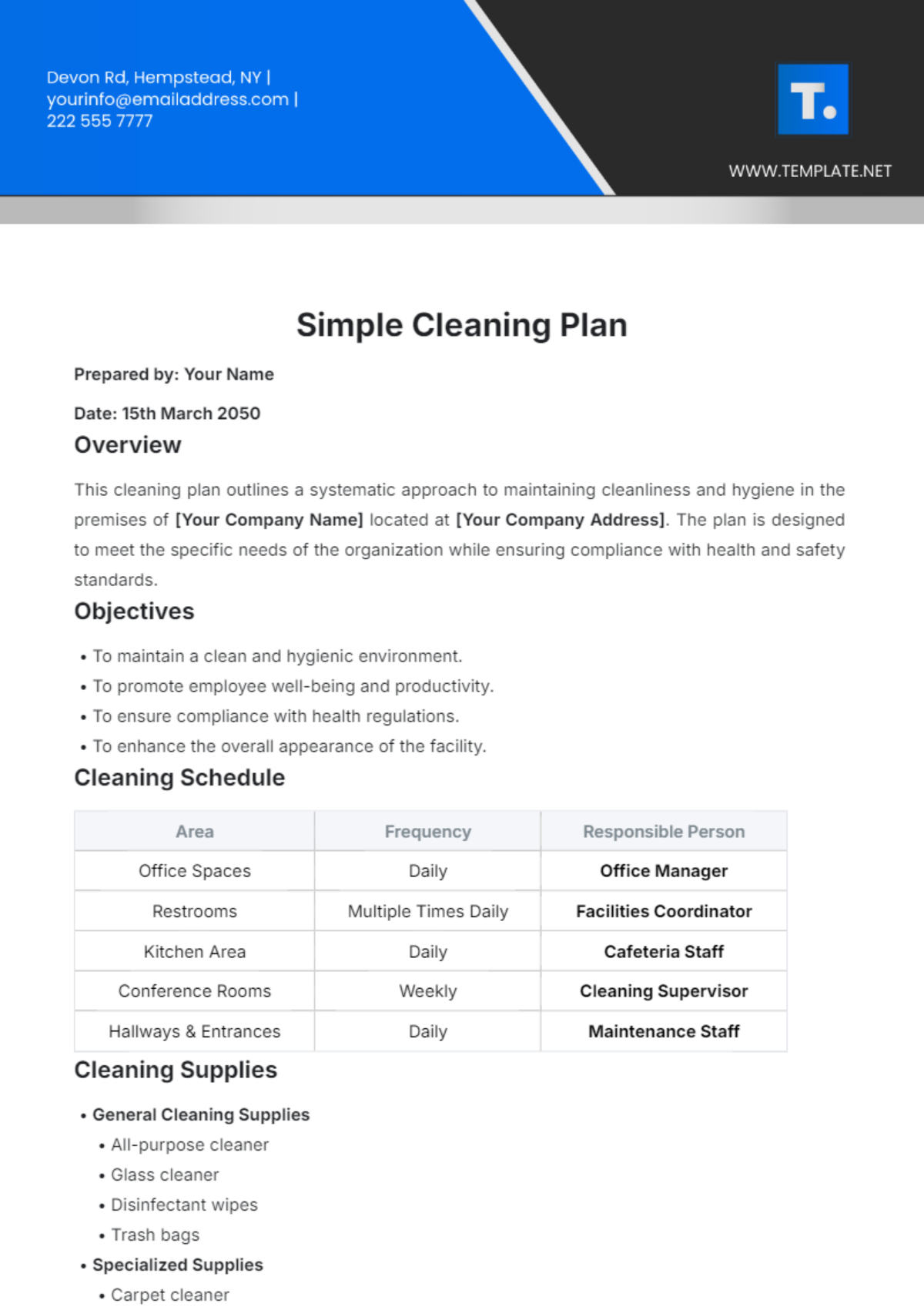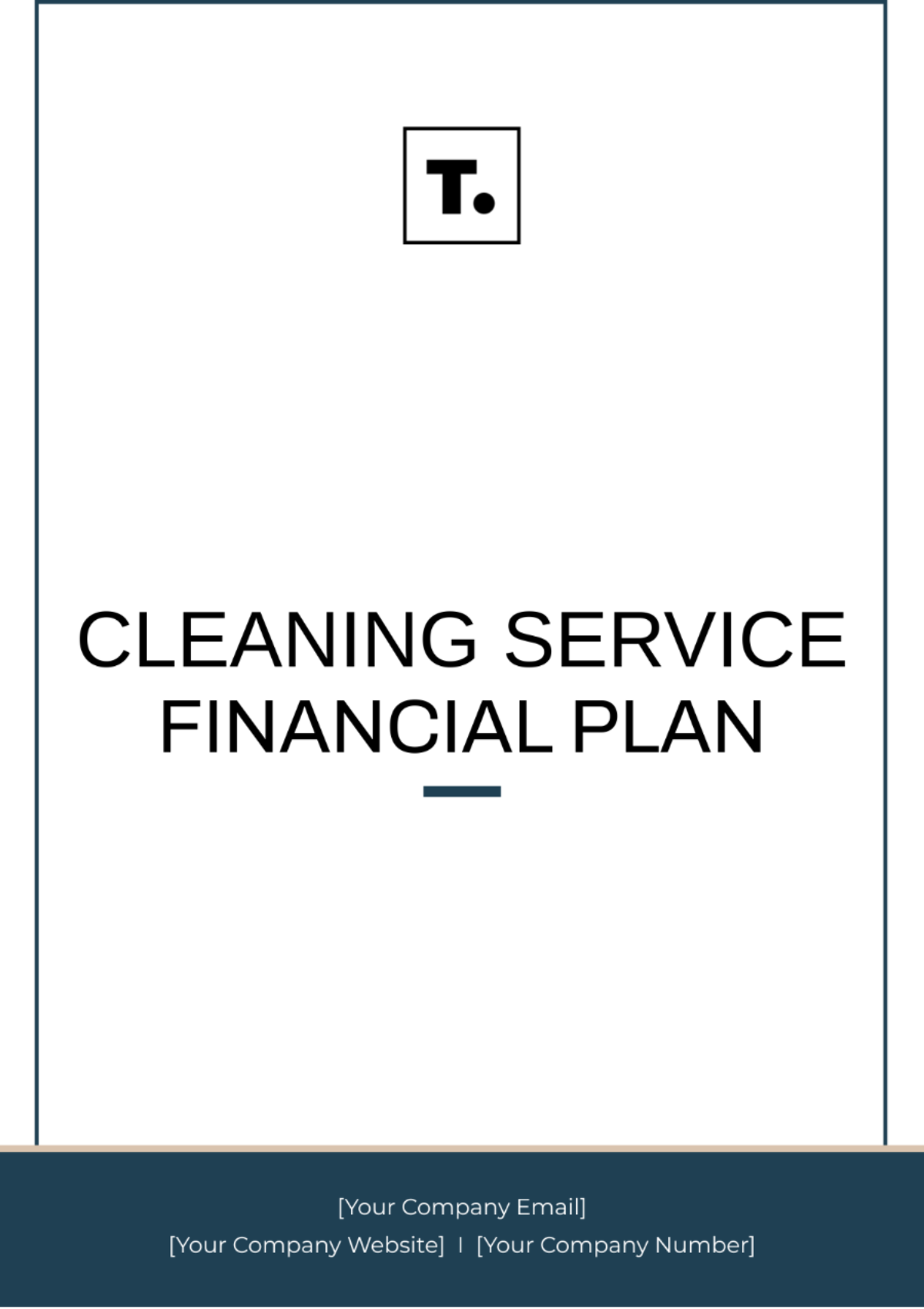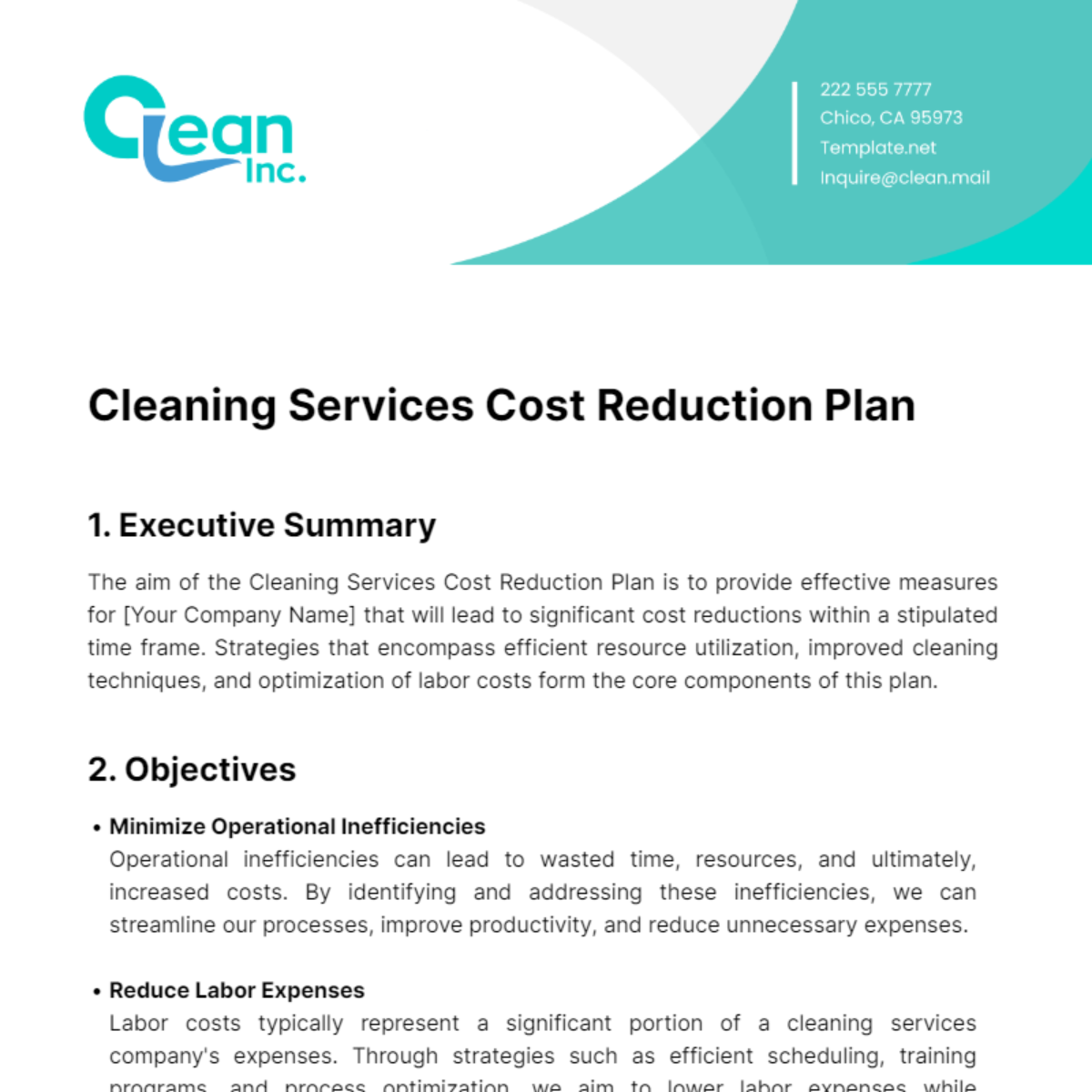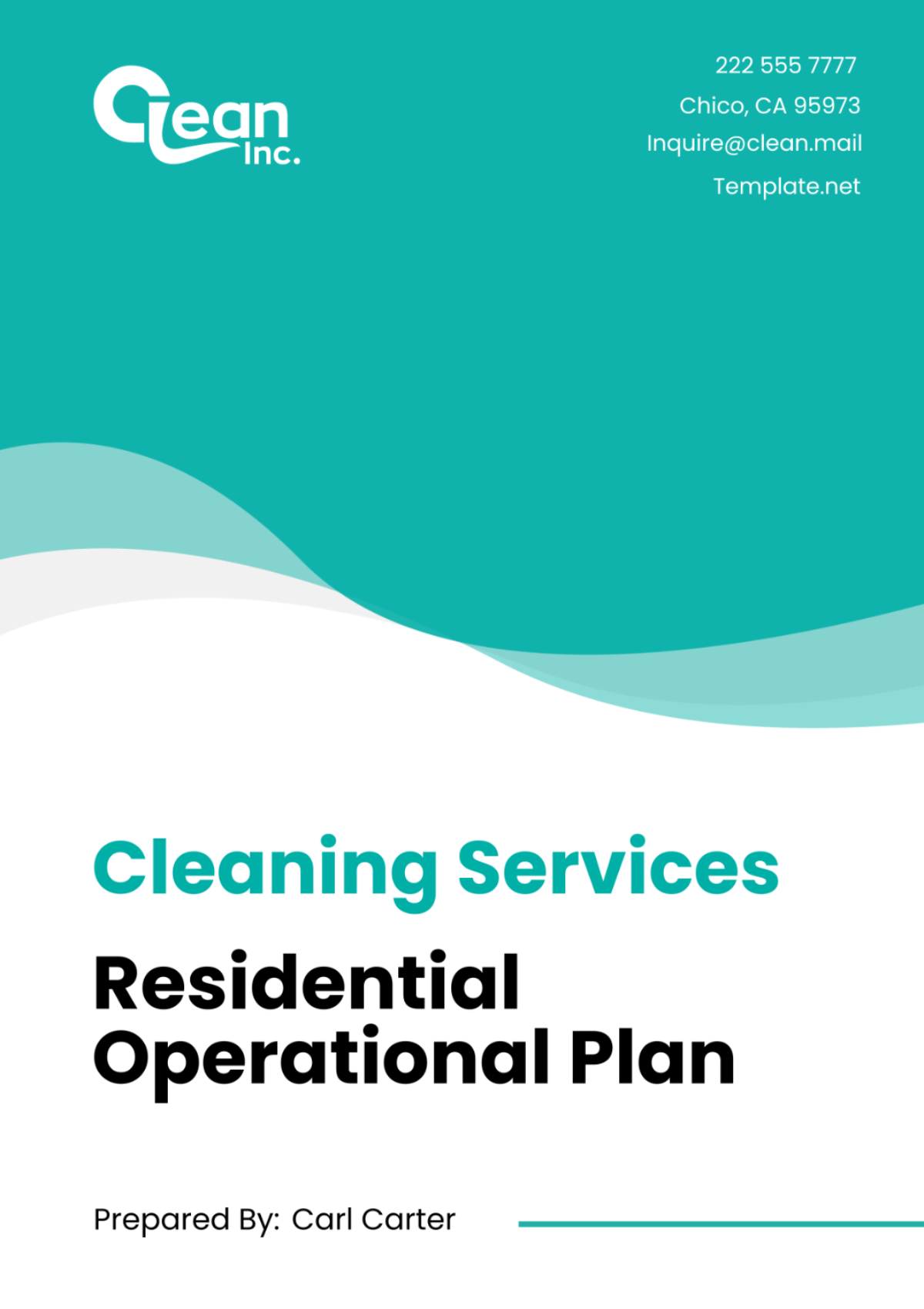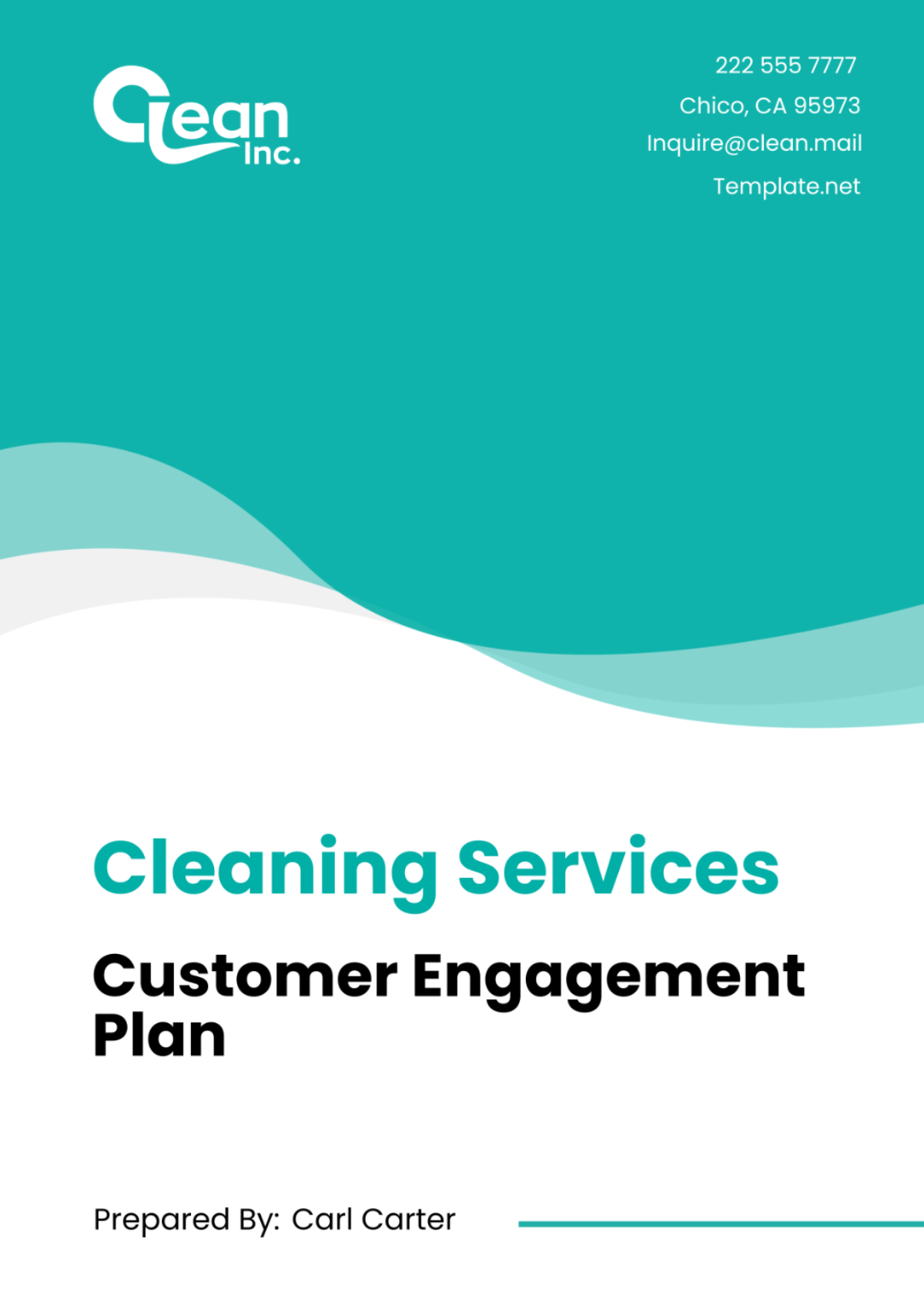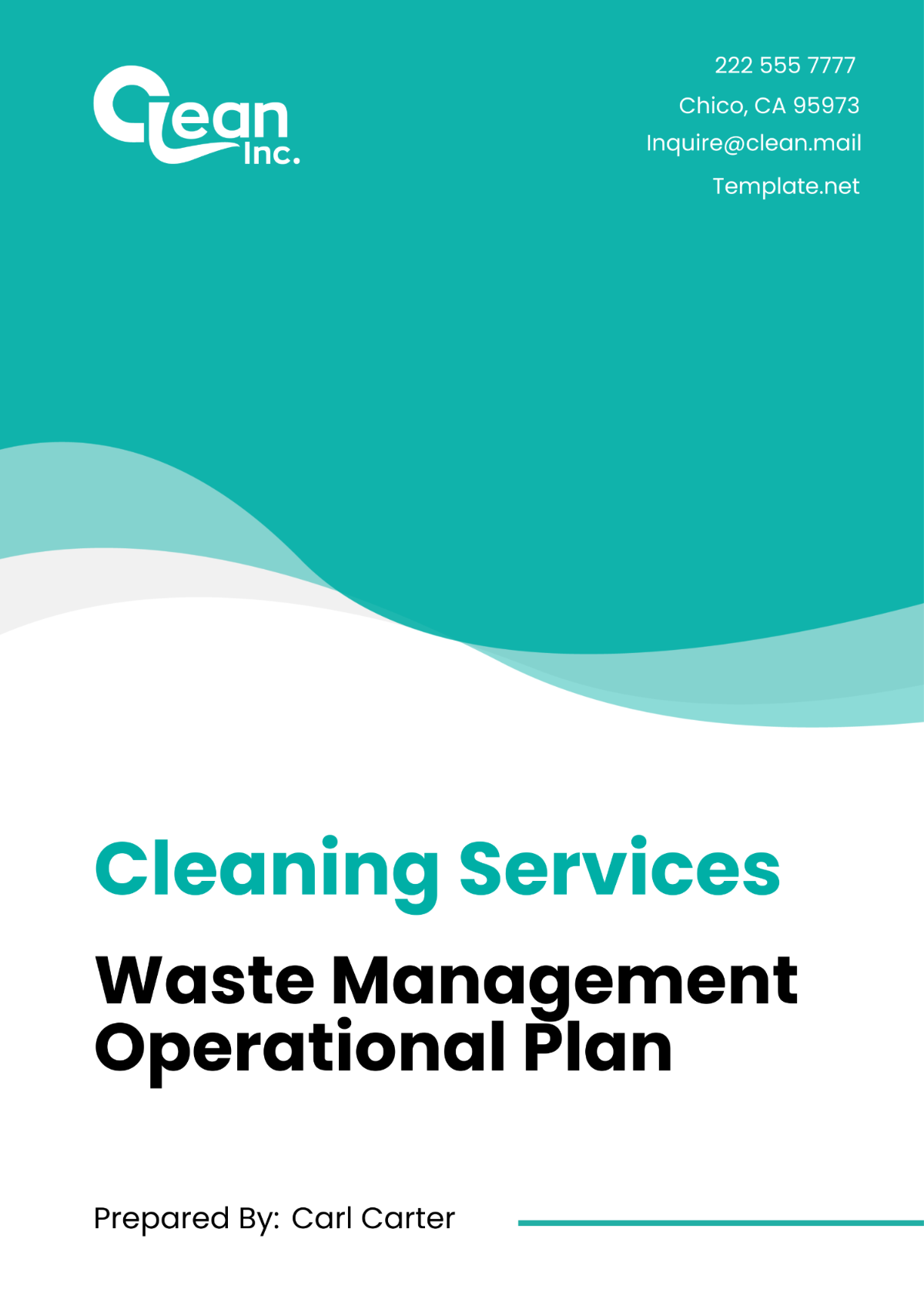Cleaning Services Resource Allocation Plan
I. Introduction
A. Purpose of Resource Allocation
Efficient Resource Utilization: Our paramount objective is to allocate resources judiciously. By doing so, we optimize the deployment of personnel, equipment, and materials across our cleaning projects. This efficiency translates into cost savings and improved service delivery.
Cost-Effectiveness and ROI: Effective resource allocation directly impacts our bottom line. We meticulously balance quality service delivery with prudent financial management. Our investments yield a favorable return on investment (ROI) by enhancing client satisfaction and retention.
Client-Centric Approach: Well-allocated resources lead to consistent, high-quality cleaning services. Satisfied clients become our brand advocates, driving referrals and business growth.
B. Context and Scope
Our Cleaning Services: [Your Company Name] specializes in a wide spectrum of cleaning services, catering to both residential and commercial clients. From office spaces to homes, we leave no nook unturned. Our services encompass routine maintenance, deep cleaning, and specialized treatments.
Geographical Coverage: Our reach extends across the various states, ensuring cleanliness and hygiene for diverse communities. Whether it’s bustling urban centers or serene suburban neighborhoods, we’re there.
Industry Standards and Compliance: We adhere rigorously to industry standards, safety protocols, and environmental considerations. Our commitment to sustainability aligns with global best practices.
C. Guiding Principles
Flexibility and Adaptability: Our resource allocation plan remains agile. Whether it’s a routine office cleaning or an emergency spill cleanup, we tailor our approach. Flexibility allows us to meet dynamic demands.
Transparency and Communication: We maintain open channels with clients. Regular updates on resource allocation foster trust and transparency. Clients appreciate knowing how their cleaning needs are prioritized.
Continuous Improvement and Innovation: Regular reviews and refinements ensure that our resource allocation practices evolve alongside industry trends and client expectations. We embrace new technologies and methodologies.
Sustainability and Eco-Consciousness: Beyond cleanliness, we’re stewards of the environment. Resource allocation includes responsible waste management, eco-friendly product choices, and energy-efficient practices.
II. Resource Categories
A. Human Resources
Our dedicated human resources form the backbone of our cleaning services. Their expertise, commitment, and teamwork drive our success. Let’s delve into the specifics of our human resource allocation:
Cleaning Staff
Our skilled cleaning staff ensures that every surface gleams and every corner sparkles. Here’s how we allocate and manage this vital resource:
1.1. Recruitment and Training
1.1.1. We meticulously recruit individuals with a passion for cleanliness and attention to detail. Our hiring process involves thorough interviews and background checks.
1.1.2. New hires undergo rigorous training, covering safety protocols, cleaning techniques, and customer service etiquette. We emphasize the importance of professionalism and client satisfaction.
1.2. Task Allocation and Specialization
1.2.1. Our cleaning staff is adept at various tasks, from dusting to carpet shampooing. Each team member has specific areas of expertise.
1.2.2. We allocate tasks based on their strengths and preferences. For instance, someone with an eye for detail might handle intricate glass surfaces, while another excels at floor maintenance.
1.3. Shift Scheduling and Flexibility
1.3.1. We maintain flexible schedules to accommodate client needs. Our staff adapts to varying work hours.
1.3.2. Whether it’s early morning office cleaning or late-night post-event cleanup, our team remains committed.
Supervisors
Our supervisors play a pivotal role in overseeing operations and maintaining service excellence:
2.1. Leadership and Guidance
2.1.1. Supervisors lead by example, demonstrating professionalism, work ethic, and effective communication.
2.1.2. They guide cleaning teams, ensuring adherence to standards and best practices.
2.2. Quality Control and Inspections
2.2.1. Regular inspections fall under their purview. They meticulously assess completed tasks, providing constructive feedback.
2.2.2. If a client requests a specific focus area, supervisors ensure it receives the necessary attention.
Resource Coordination and Workload Management
3.1. Supervisors allocate staff to specific projects based on skill levels and project requirements.
3.2. Balancing workloads is crucial to maintaining efficiency and meeting deadlines.
Administrative Staff
Behind the scenes, our administrative team keeps things running smoothly:
4.1. Scheduling and Communication
4.1.1. They manage client appointments, ensuring timely service delivery. Clear communication channels are essential.
4.1.2. Administrative staff promptly address client queries, reschedule appointments if needed, and maintain a positive client experience.
4.2. Inventory Management and Procurement
4.2.1. Administrative staff track cleaning supplies and equipment inventory. They monitor stock levels and reorder as needed.
4.2.2. Preventing shortages during critical tasks is a priority. They also explore cost-effective procurement options.
4.3. Client Relations and Feedback Loop
4.3.1. Building strong client relationships is part of their role. They actively seek feedback and address any concerns.
4.3.2. Client satisfaction drives our continuous improvement efforts.
B. Equipment and Supplies
The following table outlines the essential cleaning equipment and supplies utilized in our operations:
Item | Description | Availability |
|---|---|---|
Vacuum Cleaners | High-powered vacuum cleaners for efficient floor and upholstery cleaning. | Available for all projects. |
Mops and Brooms | Various types of mops (wet, dry, microfiber) and sturdy brooms for sweeping and spot cleaning. | Always stocked. |
Cleaning Solutions | Diverse range of eco-friendly detergents, disinfectants, and stain removers. | Regularly replenished. |
Microfiber Cloths | Soft, lint-free cloths for dusting, wiping surfaces, and glass cleaning. | Abundant supply. |
Trash Bags | Heavy-duty bags for waste collection and disposal. | Always on hand. |
Window Squeegees | Professional-grade squeegees for streak-free window cleaning. | Available for window projects. |
Floor Polishers | Electric or battery-powered machines for floor buffing and polishing. | Reserved for large-scale floor maintenance. |
The availability of well-maintained equipment ensures consistency in our cleaning services. Whether it’s vacuuming carpets, polishing floors, or wiping down surfaces, using the same reliable tools across projects maintains uniformity.
Adequate supplies prevent interruptions during tasks. Imagine running out of cleaning solution mid-project—it’s inefficient and frustrating. Availability ensures seamless operations.
Satisfied clients become loyal patrons. They recommend our services to others. Consistent quality, made possible by proper equipment and supplies, drives repeat business.
In summary, these resources aren’t mere tools; they’re the backbone of our cleaning services. Their availability and effective utilization directly impact our reputation, client satisfaction, and operational efficiency.
C. Budget Allocation
The financial aspect of our resource allocation plan is critical for sustaining efficient operations. Proper budget allocation ensures that we allocate funds judiciously to meet our cleaning service needs. The following table outlines the budget allocation for our cleaning services:
Item | Allocation |
|---|---|
Personnel Costs | 60% of the total budget allocated for salaries, benefits, and training of cleaning staff. |
Equipment Expenses | 20% allocated for purchasing, maintaining, and upgrading cleaning equipment and supplies. |
Marketing and Advertising | 10% set aside for promotional activities, advertising campaigns, and client outreach. |
Administrative Expenses | 5% allocated for office rent, utilities, and administrative staff salaries. |
Quality Control Measures | 5% reserved for inspections, audits, and quality assurance initiatives. |
A. Personnel Costs
Investing in Our Team: Allocating the majority of our budget to personnel costs reflects our commitment to skilled and motivated cleaning staff. Well-compensated employees are more likely to deliver exceptional service.
Training and Retention: A significant portion of this allocation goes toward training programs, ensuring our staff stays updated on industry best practices. Retaining experienced cleaners reduces turnover costs.
B. Equipment Expenses
Essential Tools: Allocating funds for equipment ensures that our cleaning staff has the necessary tools. Regular maintenance and occasional upgrades keep our equipment efficient.
Quality Over Quantity: We prioritize quality over quantity. Investing in durable, eco-friendly equipment pays off in the long run.
C. Marketing and Advertising
Client Acquisition: Allocating a portion of the budget to marketing and advertising helps us reach potential clients. Effective campaigns increase brand visibility and attract new business.
Client Retention: Regular communication with existing clients is equally important. Allocating funds for client outreach and relationship-building ensures repeat business.
D. Administrative Expenses
Smooth Operations: Allocating a small percentage to administrative costs covers office rent, utilities, and salaries for administrative staff. Efficient administrative processes keep our operations running smoothly.
Cost Control: While administrative expenses are necessary, we aim for cost-effective solutions without compromising quality.
E. Quality Control Measures
Inspections and Audits: Allocating funds for quality control ensures that our cleaning services consistently meet high standards. Regular inspections identify areas for improvement.
Client Satisfaction: Quality control directly impacts client satisfaction. Happy clients become loyal clients and refer us to others.
In a nutshell, the process of budget allocation is inherently a strategic decision-making process. It plays a crucial role in determining and balancing where the company's financial resources are going to be invested. These areas for [Your Company Name] includes staff salaries and benefits, acquisition or maintenance of equipment, funding or improving the marketing activities, general administrative costs, and ensuring the quality control processes are up to par with the standards. The allocation of the budget in these significant areas helps in determining the growth path of the organization and its overall effectiveness.
III. Resource Allocation Process
Resource allocation is a critical aspect of effective project management. It involves strategically distributing available resources—such as labor, materials, and equipment—across various tasks or projects within an organization. Let’s explore the process in detail:
A. Define Your Project Scope
Task Breakdown: Begin by dissecting the project into individual tasks and deliverables. Whether it’s routine maintenance or specialized treatment, each cleaning job should be clearly defined. Clarity in task definition prevents ambiguity and ensures alignment among team members.
Work Breakdown Structure (WBS): Utilize tools like a WBS or project planning software to visualize all project tasks. This hierarchical breakdown allows you to see the project’s components, dependencies, and resource requirements. A well-structured WBS simplifies resource allocation decisions and enhances project planning.
Resource Identification: Understand what resources—both human and material—you’ll require for each task. Consider specific skills needed for cleaning staff, the equipment necessary, and the quantities of cleaning supplies. Proper resource identification ensures efficient allocation and prevents shortages.
B. Estimate Resource Needs
People: Estimate the number of cleaning staff required. Consider their expertise, availability, and workload distribution. Skilled personnel directly impact service quality. Properly allocating staff ensures efficient coverage across projects.
Equipment: Assess the equipment needed for different tasks. Vacuum cleaners, floor polishers, and specialized tools all play distinct roles. Adequate equipment ensures efficient operations and consistent results. For example, allocating floor polishers for periodic maintenance keeps floors pristine.
Materials: Estimate the quantity of cleaning supplies—detergents, microfiber cloths, trash bags, etc.—for each project. Proper estimation prevents interruptions during tasks and ensures seamless operations.
Budget: Allocate funds for resource procurement. Balancing quality and cost is crucial. Striking this balance ensures sustainable operations without compromising excellence.
C. Effective Resource Allocation
Resource Availability: Ensure that the right people and equipment are available when needed. Efficient scheduling prevents bottlenecks and keeps projects on track. Properly allocated resources prevent delays and maintain productivity.
Prioritization: Allocate resources based on project priorities. Urgent tasks may require immediate attention. Prioritizing critical work ensures efficient resource utilization.
Resource Tracking: Continuously monitor resource usage. Adjust allocations as needed to maintain efficiency. Regular checks prevent resource shortages and optimize utilization.
Quality Control: Regular assessments ensure that allocated resources meet quality standards. Adjustments may be necessary to maintain consistent service quality.
D. Consistent Quality Control
Inspections and Audits: Regularly review project progress through inspections and audits. Inspect completed tasks to ensure they meet cleaning standards.
Client Satisfaction: Quality directly impacts client satisfaction. Consistent service quality builds trust and loyalty.
IV. Resource Allocation Strategies
Resource allocation is a dynamic process that requires thoughtful planning and adaptability. By implementing effective strategies, we can maximize resource utilization, enhance productivity, and deliver exceptional cleaning services. Let’s delve into the specifics:
A. Staff Optimization
Skill-Based Allocation
1.1. Assign cleaning staff based on their expertise. For specialized tasks (e.g., carpet cleaning, window washing), allocate team members with relevant skills.
1.2. Cross-train staff to handle multiple responsibilities, ensuring flexibility during peak demand.
Workload Balancing
2.1. Distribute workloads evenly among cleaning staff. Avoid overburdening certain individuals while others remain underutilized.
2.2. Regularly assess staff availability and adjust allocations as needed.
Shift Scheduling
3.1. Optimize shift schedules to align with peak cleaning hours. Allocate more staff during busy periods (e.g., after events or office hours).
3.2. Consider staggered shifts to maintain continuous coverage.
B. Equipment Efficiency
Equipment Rotation
1.1. Rotate equipment usage to prevent wear and tear on specific machines. Regular maintenance ensures optimal performance.
1.2. Distribute workload across vacuum cleaners, floor polishers, and other tools.
Equipment Reserves
2.1. Maintain spare equipment for emergencies. Having backup vacuum cleaners and other essentials prevents disruptions.
2.2. Allocate resources for equipment repairs promptly.
Technology Integration
3.1. Explore smart cleaning solutions. Automated floor scrubbers, sensor-based trash bins, and energy-efficient appliances enhance efficiency.
3.2. Allocate resources for technology upgrades as needed.
Supplier Relationships
4.1. Cultivate strong relationships with equipment suppliers. Reliable partners ensure timely replacements and repairs.
4.2. Diversify suppliers to reduce dependence on a single source.
C. Materials Management
Inventory Control
1.1. Regularly assess cleaning supplies inventory. Allocate resources for restocking when levels are low.
1.2. Prevent shortages during critical tasks.
Quality vs. Quantity
2.1. Prioritize quality cleaning supplies over quantity. Effective detergents, microfiber cloths, and trash bags yield better results.
2.2. Allocate resources for eco-friendly and effective materials.
Bulk Purchasing
3.1. Consider bulk purchases for cost savings.
3.2. Allocate budget for strategic bulk buying of essential supplies.
3.3. Proper storage prevents spoilage or deterioration.
Waste Reduction
4.1. Allocate resources for waste management. Proper disposal of used cleaning supplies minimizes environmental impact.
4.2. Promote recycling and responsible waste handling.
V. Contingency Planning
Contingency planning ensures that our cleaning services remain resilient in the face of unforeseen challenges. By proactively addressing risks, we can allocate resources effectively even when disruptions occur. Let’s explore the specifics:
A. Identify Potential Risks
Risk Assessment
1.1. Begin by identifying potential risks specific to our cleaning projects. These could include equipment breakdowns, staff shortages, supply chain disruptions, or unexpected client requests.
1.2. Consider both internal and external factors that may impact resource availability.
Scenario Analysis
2.1. Conduct scenario-based assessments. What if a key staff member falls ill? What if a critical piece of equipment malfunctions?
2.2. Anticipate various scenarios to understand their resource implications.
Resource-Specific Risks
3.1. Consider risks related to personnel, equipment, and materials. For example, staff turnover or sudden material shortages.
3.2. Each resource category may have unique risks that require contingency planning.
B. Allocate Contingency Resources
Financial Contingency:
1.1. Set aside additional funds as cost contingency. These extra funds act as a buffer to cover unforeseen expenses.
1.2. Allocate a percentage of the budget specifically for handling unexpected resource needs.
Time Contingency
2.1. Build extra time into project schedules. Contingency time allows us to address delays caused by unforeseen events.
2.2. Avoid rigid deadlines that leave no room for adjustments.
Resource Buffer: Maintain a reserve of critical resources. For example, keep spare vacuum cleaners, microfiber cloths, and cleaning solutions. Having surplus resources ensures continuity during emergencies.
Staff Cross-Training: Cross-train cleaning staff to handle multiple tasks. If one team member is unavailable, others can step in. Versatile staff allocation minimizes disruptions.
Supplier Relationships
5.1. Cultivate strong relationships with suppliers. In times of scarcity, reliable suppliers can prioritize our needs.
5.2. Diversify suppliers to reduce dependence on a single source.
C. Activation and Monitoring
Trigger Points
1.1. Define triggers that activate contingency plans. For instance, if a critical piece of equipment breaks down or if staff absenteeism exceeds a certain threshold.
1.2. Be proactive rather than reactive.
Resource Replenishment
2.1. Regularly assess resource levels. Replenish contingency resources promptly.
2.2. Monitor stock levels for cleaning supplies, equipment spare parts, and staff availability.
Communication Protocols
3.1. Establish clear communication channels during emergencies. Ensure all team members know whom to contact.
3.2. Quick communication prevents resource bottlenecks.
Review and Adaptation
4.1. Periodically review and update contingency plans. As risks evolve, our responses must adapt.
4.2. Learn from past incidents to enhance future resource allocation.
In summary, contingency planning in resource allocation safeguards our cleaning services against disruptions. By allocating contingency resources wisely, we ensure seamless operations even when the unexpected occurs.
VI. Conclusion
In the dynamic landscape of cleaning services, effective resource allocation is the linchpin that holds our operations together. By allocating the right people, equipment, and materials to the right tasks, we optimize productivity.
Our plan ensures that cleaning staff are where they’re needed most, equipment operates seamlessly, and supplies never run dry. This efficiency translates into satisfied clients and repeat business.
Contingency planning, a key component of resource allocation, prepares us for the unexpected. Whether it’s a sudden equipment breakdown or unforeseen staff shortages, we’re ready. By allocating contingency resources and monitoring triggers, we minimize disruptions. Our ability to adapt ensures uninterrupted service delivery.
Ultimately, resource allocation serves our clients. Cleanliness and hygiene are non-negotiable for them, especially in today’s health-conscious environment. Our commitment to efficient resource allocation directly impacts client satisfaction. When they see well-equipped staff delivering consistent results, they trust us with their spaces.
In summary, resource allocation isn’t just a plan—it’s our compass. It guides us toward operational excellence, financial stability, and client delight. As we implement this plan, let’s remember that every allocation decision contributes to success!
